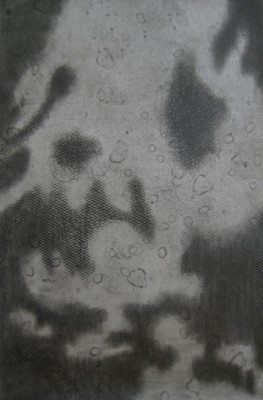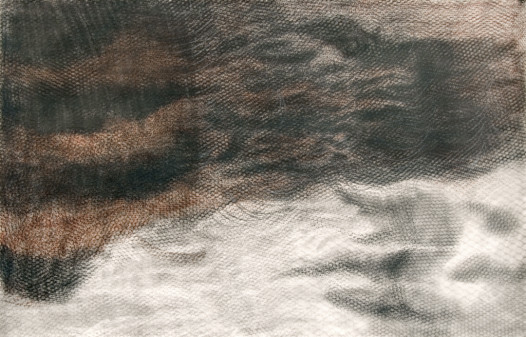Communication Breakdown
Milko Pavlov in correspondence with Philip Zidarov
There exist an infinite number of invisible pictures. We succeed in grasping a trifling part of them which is indispensable for human life. That invisible reservoir constantly feeds and supports us on the one hand and, on the other, challenges us and imposes some sense of weightlessness, regardless of the particular circumstances we live in.
The endless sea of images appearing and disappearing simultaneously is impossible to perceive, so we are content with distorted pictures – fragments, and those fragments are convincing in as much as they manage to suggest the integrity of the whole/the boundless. It is clear that events let only a small part of them be captured; in that sense the reproduction of the invisible becomes an instrument of knowledge (limited in itself) and, regardless of any technical or scientific progress, the main content is lost in speculation. Knowledge, for its part, changes the world irreversibly and pushes us to the unknown, where the essence of reproductions appears to be: the good ones always contain the thrilling unknown, no matter whether they tell a story or synthesize. No matter to what extent a limited form (in this case the reproduction) embodies something infinite, there remain unanswered the questions of whether that limited form is a particle of the infinite, whether it is changeable, to what extent it is knowable and whether it can act beyond the parameters reported by it, i.e. outside its own description.
There are an infinite number of pictures not yet drawn. And the more we draw, the more numerous they become.
Philip Zidarov:
The question is where these images exist. Is it consciousness that gives them an image, or are images deciphered by consciousness? Certainly, in the latter case the extent of deciphering could not be established as it is most probably a variable. And it is the x of this equation that represents the depot of the invisible pictures.
The most precise analogy is still the allegory of Book 7 of Plato’s Republic: Mankind looks like a group of people spending their whole life in a cave and perceiving reality only through the images of the shadows thrown by the light of the outside world on the cave walls. His previous book contains the analogy of the divided line, representing the ratio between the visible and knowable parts of the universe, thus postulating transcendental relativism and the limits of knowledge itself. In this sense, each picture proves to be an image made mainly by its “non-depicted” elements, by an uncounted number of unlocked doors, each of which is ready to be opened and leads to new images.
Milko Pavlov:
In light of this conversation, we cannot avoid the question of whether time is information or communication. What part is it possible to perceive, or shall we realize, a priori, that information is actually misleading? Deformations (distortions of information) are a superficial element whose absence, however, makes any communication impossible, and deformation is existentially necessary. Further down along this path art becomes possible at a moment of “communication breakdown”, namely in the state of paradox. Objects are the same and not the same simultaneously: they speak a language we understand but it is impossible to follow logically.
I do not remember the reasons why in 2005 I started dating in the future. The pretence of mapping various points of the unknown produces images that would in no way differ from those dated ”today“. At the same time, the work acquires the
right of “bilocation” – to be simultaneously here and now, and there, where it came from, a right inherent in everything in the foreseeable world. Thus the notion of modernity extends its parameters beyond measurable time, overcomes the syndrome of periodicity expected from it, with no risk of self-destruction.
Philip Zidarov:
Such tactics itself contain a paradox. The game of dating “in the future” probably comes closest to manipulating the relativity of what we take as a landmark (in Christian, Islamic, Jewish or Roman chronology) because the Year 1 of every other calendar is always different (and strictly private). That also relates to the pretence of mapping the points of the unknown, as at the moment of their “mapping” all unknown points turn into known ones, i.e. ones already found.
On the other hand, I am not convinced that art is created in the zones of breakdown of communication options, because art is 100% communication, above all as a means (or attempt) of the author, artist, to communicate with himself. (This makes me recall the old times youth magazine Cosmos, where Karl Marx’s notorious saying that “there is nothing in this world but moving matter” was printed on each edition cover.) The very process of communication, whatever it may be, becomes senseless without causality, and your hypothetical parallel bi-locality has its closest analog with a traveler in time who meets himself. It implies the theoretical option of containing a potentially self-destructive paradox – for instance, if during the meeting with himself the traveler in time kills his avatar, then he will not be born and the meeting wouldn’t be (have been) possible.
Milko Pavlov:
In “Plato’s cave” the light of the world (as you said) causes the existence of shadows. The same allegory also mentions that there are people who go outside and see the light. When they go back and try to convince the rest that there are only illusions inside, they get killed because they have become inconvenient for the system, which Plato calls the State. In his concept of the Ideal State he recommends having poets evicted, i.e. art provoking public communication is pronounced a harmful illusion. This is why I prefer to call art the moments of “communication breakdown”, challenging the established communication system inside the cave.
Perhaps it is not accidental that around Plato’s time the old Jewish doctrine banning images was formulated. Back then they were already exhausted in terms of meaning by Egypt and Babylon. Moreover, in Egypt there was the proto-image of the matrix, which has been the topic of discussions on many levels ever since. It is interesting for me that back then, the new ideas about the world emerged in marginal spaces – a principle that looks valid even today. We all know that, in the broader sense, the wars pro and anti the image (relating both to images and painting in general) go on even today. The conceptual tendencies are in their essence Platonist, rational formulae, excluding the image. They are interesting when they manage to overcome their own borders, when they go beyond their own concept and let in “the light of the world” – when a sense of picture is accomplished with non-painting means and the hegemony of shadows is disputed.
However, the general level of these quests actually proves to be a somewhat hollow and easily understandable conceptual academicism (Plato again!). At a profane level, there is a coincidence that Protestants, Nazis, communists and Islamists stand radically against the picture (as a means of knowledge). Their concepts accept the picture only in its capacity of martial means (doctrine, dogma, propaganda), and they use it masterfully. It comes to mind that, whereas Plato evicts the poets from his State, for Lenin the artist is “an idiot, useful though”, and Nazis and Islamists lack variants.
Shadows are acted out in ever better ways, new and interesting ways are fabricated in accordance with the permanent struggle “new against old”. Society does not want to see the light, as it seems to prefer to exist in a state of zombie conformism. And still, there is light – at times it hardly sifts through and at other times it blinds the viewer. In my view, Heisenberg marks the beginning of the End of the Age of Enlightenment by showing that “… science is a sweet drink, the first sip of which makes us atheists but at the bottom of the glass God is waiting for us
Before him, Nietzsche pronounced God dead, and even before that Karl Marx read somewhere that there was nothing else in the world but ever-moving matter, which is a saying that is almost after Isaac Newton.
However, the questions of what is the driving force moving the matter, and what is actually matter, remain an aspect of the same paradox in which we live.
“Communication breakdown” is the place of terminating public communication and it offers an option to sense time in a different way – not just for the private use of artists. If χρόνος (chronos) is the measurable process (communication), καιρός (kairos) is a place, point, or area mixing past, present and future. The paradoxical combination of simultaneous non-simultaneity is effected namely by energy. Such is the case with dating in the future and my exhibition in the Sofia City Art Gallery ending in 2056 with an exhibition titled 100 years Milko Pavlov in the same building, further to a notarized contract between artist and gallery. There is also a video instruction on reconstructing the visual situation. The process also involves a risk factor – it is certainly not clear if it will happen and this is what makes it interesting.
Philip Zidarov:
There is a very curious conflict between system and image. Firstly, because the very system, no matter what it is, has an image of its own through which it materializes in space-time. This image, however, cannot stand another image besides its own, because (radically) different images create new systems, usually destroying the previous ones. So this proves to be a reaction of self-protection. So the more totalitarian a system is, be it in an authoritarian or fundamentalist manner (which often appears to be identical), the less tolerant it is towards “alien” images. Its “own”, tolerated images are the ones creating static and extra-temporal character (or stopping of time), whereas the „hostile” have (or allegedly have) the opposite characteristics.
 In the extreme iconoclastic variant of the monotheistic religions – Judaism, Islam or radical Christian denominations – the image is transformed into a symbol of the imaginary religious antipode – polytheism, and hence entirely ostracized socially.
In the extreme iconoclastic variant of the monotheistic religions – Judaism, Islam or radical Christian denominations – the image is transformed into a symbol of the imaginary religious antipode – polytheism, and hence entirely ostracized socially.
Ultimately, it all seems to depend on the type of “cave” and the rules of communication in effect there (and outside). The history of civilization and art (despite Plato’s fears) indicates a very good synchrony between art and a valid communication system. The modern era was the first to give birth to the phenomenon “art against system” – it is enough to read again Marinetti’s Manifesto. However, with the establishment of a tolerant (or close to such) social system in big portions of the contemporary world, art and artists are no longer a danger for its existence, so the choice between radical or conformist artistic practices and behaviors has turned into a matter of preference (or artistic talent) of the very artist.
Next:
Tipps 3
by Fabian Ginsberg
